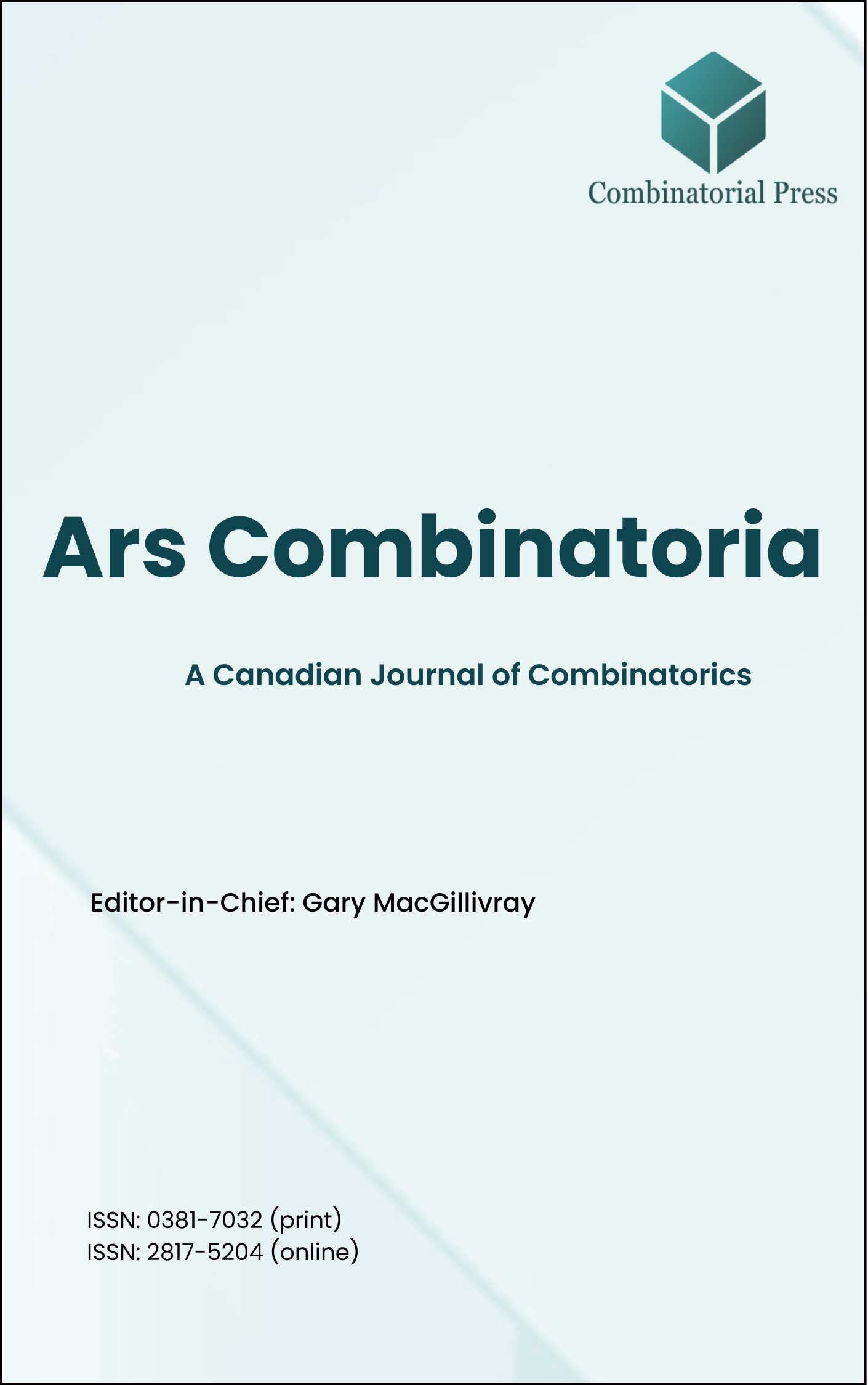
Ars Combinatoria
ISSN 0381-7032 (print), 2817-5204 (online)
Ars Combinatoria is the oldest Canadian Journal of Combinatorics, established in 1976. The journal is dedicated to advancing the field of combinatorial mathematics through the publication of high-quality research papers. From 2024 onward, it publishes four volumes per year in March, June, September and December. Ars Combinatoria has gained recognition and visibility in the academic community and is indexed in renowned databases such as MathSciNet, Zentralblatt, and Scopus. The Scope of the journal includes Graph theory, Design theory, Extremal combinatorics, Enumeration, Algebraic combinatorics, Combinatorial optimization, Ramsey theory, Automorphism groups, Coding theory, Finite geometries, Chemical graph theory but not limited.
Information Menu
- Research article
- Full Text
- Ars Combinatoria
- Volume 039
- Pages: 129-138
- Published: 30/04/1995
- Research article
- Full Text
- Ars Combinatoria
- Volume 039
- Pages: 121-127
- Published: 30/04/1995
The \(i\)-center \(C_i(G)\) of a graph \(G\) is the set of vertices whose distances from any vertex of \(G\) are at most \(i\). A vertex set \(X\) \(k\)-dominates a vertex set \(Y\) if for every \(y \in Y\) there is a \(x \in X\) such that \(d(x,y) \leq k\). In this paper, we prove that if \(G\) is a \(P_t\)-free graph and \(i \geq \lfloor\frac{t}{2}\rfloor \), then \(C_i(G)\) \((q+1)\)-dominates \(C_{i+q}(G)\), as conjectured by Favaron and Fouquet [4].
- Research article
- Full Text
- Ars Combinatoria
- Volume 039
- Pages: 109-119
- Published: 30/04/1995
As a generalization of a matching consisting of edges only, Alavi et al. in [1] define a total matching which may contain both edges and vertices. Using total matchings, [1] defines a parameter \(\beta’_2(G)\) and proves that \(\beta’_2(G) \leq p-1\) holds for a connected graph of order \(p \geq 2\).
Our main result is to improve this inequality to \(\beta’_2(G) \leq p-2\sqrt{p}+{2}\) and we give an example demonstrating this bound to be best possible.
Relations of several other parameters to \(\beta’_2\) are demonstrated.
- Research article
- Full Text
- Ars Combinatoria
- Volume 039
- Pages: 97-108
- Published: 30/04/1995
We examine permutations having a unique fixed point and a unique reflected point; such permutations correspond to permutation matrices having exactly one \(1\) on each of the two main diagonals. The permutations are of two types according to whether or not the fixed point is the same as the reflected point. We also consider permutations having no fixed or reflected points; these have been enumerated using two different methods, and we employ one of these to count permutations with unique fixed and reflected points.
- Research article
- Full Text
- Ars Combinatoria
- Volume 039
- Pages: 93-96
- Published: 30/04/1995
Let \(G\) be a graph and \(t(G)\) be the number of triangles in \(G\). Define \(\mathcal G_n\) to be the set of all graphs on \(n\) vertices that do not contain a wheel and \(t_n = \max\{t(G) : G \in \mathcal G_n\}\).
T. Gallai conjectured that \(t_n \leq \lfloor\frac{n^2}{8}\rfloor\). In this note we describe a graph on \(n\) vertices that contains no wheel and has at least \(\frac{n^2+n}{8}-3\) triangles.
- Research article
- Full Text
- Ars Combinatoria
- Volume 039
- Pages: 89-92
- Published: 30/04/1995
A construction is given which uses \(\text{PG}_i(d, q)\) and \(q\) copies of \(\text{AG}_i(d, q)\) to construct designs having the parameters of \(\text{PG}_{i+1}(d+1, q)\), where \(q\) is a prime power and \(i \leq d-1\).
- Research article
- Full Text
- Ars Combinatoria
- Volume 039
- Pages: 75-88
- Published: 30/04/1995
In a previous paper, [6], we associated with every hyperoval of a projective plane of even order a Hadamard \(2\)–design and investigated when this design has lines with three points. We study further this problem using the concept of regular triple and prove the existence of lines with three points in Hadamard designs associated with translation hyperovals. In the general case, the existence of a secant line of regular triples implies that the order of the projective plane is a power of two.
- Research article
- Full Text
- Ars Combinatoria
- Volume 039
- Pages: 65-74
- Published: 30/04/1995
An incomplete self-orthogonal latin square of order \(v\) with an empty subarray of order \(n\), an ISOLS(\(v, n\)), can exist only if \(v \geq 3n+1\). It is well known that an ISOLS(\(v, n\)) exists whenever \(v \geq 3n+1\) and \((v,n) \neq (6m+2,2m)\). In this paper we show that an ISOLS(\(6m+2, 2m\)) exists for any \(m \geq 24\).
- Research article
- Full Text
- Ars Combinatoria
- Volume 039
- Pages: 49-64
- Published: 30/04/1995
Graceful and edge-graceful graph labelings are dual notions of each other in the sense that a graceful labeling of the vertices of a graph \(G\) induces a labeling of its edges, whereas an edge-graceful labeling of the edges of \(G\) induces a labeling of its vertices. In this paper we show a connection between these two notions, namely, that the graceful labeling of paths enables particular trees to be labeled edge-gracefully. Of primary concern in this enterprise are two conjectures: that a path can be labeled gracefully starting at any vertex label, and that all trees of odd order are edge-graceful. We give partial results for the first conjecture and extend the domain of trees known to be edge-graceful for the second conjecture.
- Research article
- Full Text
- Ars Combinatoria
- Volume 039
- Pages: 33-48
- Published: 30/04/1995
In this paper we establish a number of new lower bounds on the size of a critical set in a latin square. In order to do this we first give two results which give critical sets for isotopic latin squares and conjugate latin squares. We then use these results to increase the known lower bound for specific classes of critical sets. Finally, we take a detailed look at a number of latin squares of small order. In some cases, we achieve an exact lower bound for the size of the minimal critical set.





